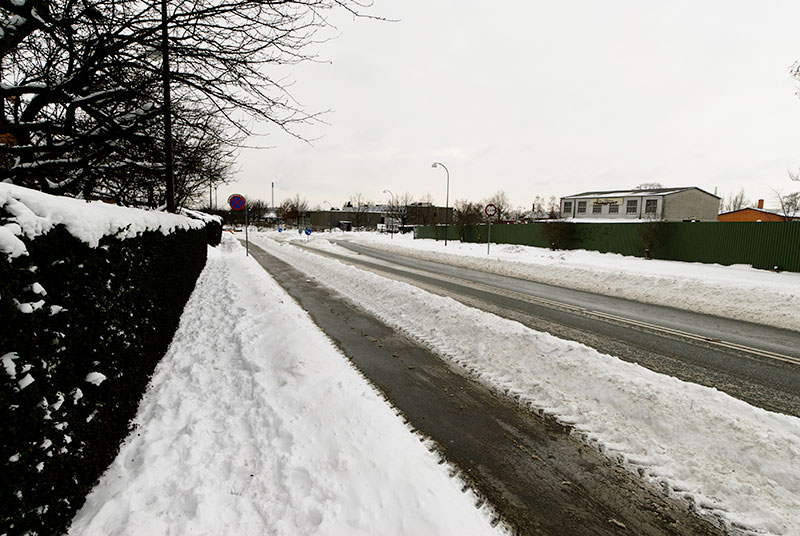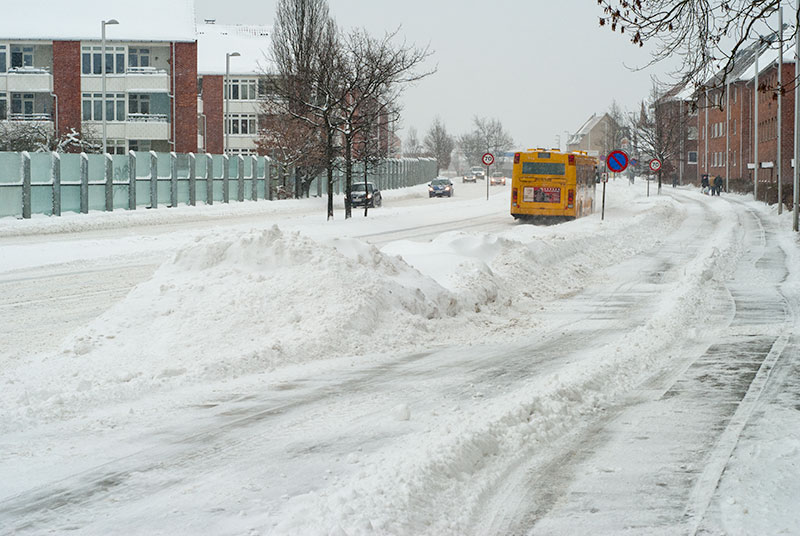During the Christmas holiday I spent a week in Denmark, where the arctic chill that affected England from the end of November also took hold. For Denmark the temperatures were not so unprecedented; within the last 50 years the sea has frozen across the Øresund belt to Sweden several times. For some photos showing the kind of conditions that I am referring to, one of the Danish newspapers has a gallery entitled “Dengang det var rigtig isvinter i Danmark” [When there were real ice winters in Denmark].
There are certain things you notice more than others when it snows in the UK. Mainly that, if you aren’t a car owner, nobody really does anything for you. Additionally, if you live somewhere that actually requires you to have a car (like in a remote village), you don’t get the same level of snow-clearance service as the towns and cities.
To a certain extent, this shows how councils are pragmatic: they do the most snow clearing where the majority live. When the budget for grit starts to run out, only the main roads and bus routes are dealt with. But where does that leave the small streets, and people without cars (this includes a lot of those I know in York)? Essentially, the council doesn’t do anything for you; some decide to put salt down on a path alongside their home. This is fine and dandy when you walk past these homes. It really is useless when you compare it with the situation in Denmark and other continental countries more adept at handling the conditions.
 One thing I give high priority is pavements. It is your civic duty to clear them in Denmark - if the pavement outside your property is not clear, you could get into trouble. In Britain last January, the “Institution of Occupational Safety and Health” gave advice to business owners that clearing your pavement could make you liable to be sued if someone has an accident after you have done the clearing. This ludicrous recommendation was spread by the media and ordinary people became reluctant to clear the footpaths by private property. See this BBC article from last year for a small overview of civic duty snow clearing).
One thing I give high priority is pavements. It is your civic duty to clear them in Denmark - if the pavement outside your property is not clear, you could get into trouble. In Britain last January, the “Institution of Occupational Safety and Health” gave advice to business owners that clearing your pavement could make you liable to be sued if someone has an accident after you have done the clearing. This ludicrous recommendation was spread by the media and ordinary people became reluctant to clear the footpaths by private property. See this BBC article from last year for a small overview of civic duty snow clearing).
The government has good, clear advice - you will not be sued if you do a good job (the media is more effective at drilling in its scaremongering though - my neighbours last year refused my help clearing their snow). The article also suggests helping elderly people with their paths. In Denmark this neighbourly attitude doesn’t always seem to hold - my 90 year old grandmother won’t leave the house while there is snow outside, and certainly can’t clear it; the neighbours didn’t seem to offer any help with clearing the snow when I was there, and the council-employed “home helpers” didn’t seem to be bothered either. But when all the pavements are cleared, you can actually get out and walk! In York the cold spell meant that I didn’t want to risk cycling; the roads were narrowed as a result of snow ploughing spoils and I daren’t trust car drivers in these conditions. I was reduced to walking in and out of town, which normally takes in the region of half an hour.
The snow covered pavements were a nightmare. If nobody was walking on them then it would be fine - I could make my way through and merely get wet feet as it melted through my shoes and socks. But when everyone decides to walk, the snow becomes compacted, then freezes into ice. In some places it wears down and the result is little pockets where you can see pavement. My half hour walk into town was elongated into almost an hour and I ended up with aching ankles for the next 2 weeks because of walking so much on the uneven surfaces. Don’t forget what happens when the temperature oscillates around freezing point…
This is why I get so excited about the little snow clearing machines, designed to fit on pavements and cycle lanes, which run up and down Copenhagen’s streets multiple times an hour when it is snowing. They brush off the snow before it has much chance to stick, and when it does, they go over several times with an effective plough-brush technique. During the rest of the year, these machines don’t just sit there doing nothing (like the big gritter lorries and ploughs you see in the UK) but have other “accessories” for other council jobs, like litter clearing, pavement sweeping etc. You even see lawnmowing tractors with snow clearing attachments, and I’m pretty sure most councils in Britain could procure those. See Copenhagenize’s fun post about the little tractors which I always like to show people.
Of course part of the Danish pavement clearing is to encourage people to use public transport and cycle/walk as much as possible (if you commute by bike, then you don’t want to have to find an alternative when the weather changes - in Copenhagen that would be a nightmare because of the numbers involved) . But also think of the accidents people don’t have - there will always be a rise in the number of A&E visits when slippery pavements mean that even younger people have nasty falls.
Hopefully my thoughts don’t come across as too opinionated; I don’t think its easy to argue against clearing pavements. To businesses worried about being sued for actually making pavements safer: you would clear the icicles off your shopfront, wouldn’t you?

